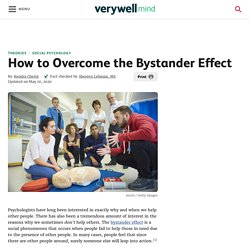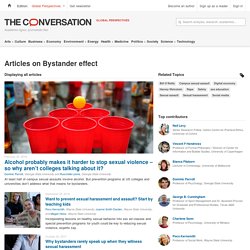

Bystander effect – APA Dictionary of Psychology. What Is the Bystander Effect? Bystander Effect. The Bystander Effect - Hook AP Psychology 1B. The bystander effect is defined as "when the presence of others hinders an individual from intervening in an emergency situation.

" If you've ever passed someone who looked in danger because you assumed someone else would come along to help, then you have fallen victim to the bystander effect. The most popular example of the bystander effect was the murder of New Yorker Kitty Genovese in 1964. While on her way home from work late at night, she was attacked and stabbed by an assailant. Over 38 people over the course of 30 minutes watched as her attacker returned again twice and stabbed her, the third time being a fatal wound.
(Source 1) Kitty Genovese died after nearly 40 people had witnessed the attacks and failed to contact the police. Bystander Effect - IResearchNet. Bystander Effect Definition Individuals who see or hear an emergency (but are otherwise uninvolved) are called bystanders.

How to Break the Bystander Effect. They could have left it to someone else. An Army veteran blocked a shooter in Oregon from entering his classroom. Three friends on a high-speed train from Paris to Amsterdam helped stop a gunman wielding an AK-47. This past spring, an Army captain in North Carolina pulled a couple to safety after a fiery car crash.
Were these men instinctively courageous, or had they learned to be? The Army captain (aptly wearing a Captain America T-shirt) credited his military training for knowing what to do and remaining calm. These heroes are dramatic examples. And this conundrum is not limited to thwarting terrorism or physically saving someone. How to Overcome the Bystander Effect. Psychologists have long been interested in exactly why and when we help other people.

Overcoming the Bystander Effect. If You’re in Danger, Will Bystanders Help? Almost every psychology student knows about Kitty Genovese, the 28-year-old Queens woman who was stabbed to death in 1964.

At the time, the New York Times reported that no one had lifted a finger to rescue her. Though that story was later debunked—some people did call the police or shout down the assailant—Genovese’s death provoked a flurry of research on what’s now called the bystander effect. According to decades of experiments, the more people who are observing someone in trouble, the less likely each person is to help.
Today, however, new studies are calling the bystander effect into question—and sketching a somewhat sunnier picture of human nature. Most recently, researchers from the U.K.’s Lancaster University, the University of Copenhagen, and elsewhere captured a series of real-life conflicts on surveillance cameras and found that at least one person in the vicinity came forward to help about 90 percent of the time. Bystander behavior, revisited Overblown coverage ―Dr. ―Dr. ―Dr. Bystander effect – News, Research and Analysis – The Conversation – page 1.
At least half of campus sexual assaults involve alcohol.

But prevention programs at US colleges and universities don’t address what that means for bystanders. Incorporating lessons on healthy sexual behavior into sex ed classes and special prevention programs for youth could be key to reducing sexual violence, experts say. Research shows that few people take a stand when they witness sexual harassment. Until that changes, this predatory behavior will haunt American workplaces.
A program developed by a University of Windsor professor significantly reduces a woman's risk of rape on campus. Preventing sexual violence is everyone's responsibility, but we need to be careful about how we do it. If you’re going to fall, injure yourself and need help, where is a good place to do it? Every now and then, and rarely far apart in time, the media features a story about an assault in public where bystanders failed to come to the victim’s aid. The legend of Kitty Genovese and those who ignored her screams. When I was growing up in New York City, everyone knew about Kitty Genovese.

We all knew the story of the 28-year-old bar manager who had been robbed, raped and stabbed to death outside her apartment building in Queens in 1964 while 38 people watched or listened to her screams outside their apartments but did nothing to stop the attack. It was more than just another tabloid murder; it was a morality tale — exhibit A for the argument that cities were alienating and dehumanizing, that there was no such thing as neighborhood or community, that people were cold, cruel, selfish, indifferent. Even today, Kitty Genovese’s name is still invoked not just in New York but around the world when people fail to come to each other’s aid in times of violence and trouble. Thirty-eight witnesses, the New York Times said, and no one did anything over the 35 minutes the attack was taking place.
Not one called the police while it was underway, even though Genovese was screaming, “Please help me. An avoidable murder of a student caught on tape: the sickening power of the bystander effect. On Sept. 17, the life of a 16-year-old high schooler in Long Island ended tragically in a violent brawl outside a strip mall.

Khaseen Morris was told to show up outside the mall at a certain time by several others his age, after he was seen walking home the girlfriend of another boy. Morris showed up and was immediately attacked by a group of five teenagers. A senseless brawl erupted and Morris was stabbed repeatedly in the chest, dying later that night in the hospital. 7 charged in stabbing death of 16-year-old broadcast on Snapchat as dozens watched. Family and friends of Khaseen Morris, the 16-year-old whose stabbing death was broadcast over Snapchat, gathered Saturday at the Tower Funeral Home in Oceanside, New York, to remember the late teen.

Meanwhile, prosecutors announced that seven suspects have been charged with gang assault in connection to Morris' death. An eighth man has already been charged with murder. The 21st century bystander effect happens every day online. If you’re going to fall, injure yourself and need help, where is a good place to do it?

Should you choose a busy thoroughfare or a deserted backstreet? Statistics and experiments in social psychology will tell you that if you need help, you should avoid dropping in a busy street, even if hundreds of people are passing through. This is because of a phenomenon known as the bystander effect. The more individuals gathered in one place, the less chance there is of one of them coming to the aid of a person in need.
When an emergency situation occurs, it’s more likely that someone will come to the rescue if there are fewer or almost no witnesses. And in the 21st century, when our thoroughfares are online and on social networks, millions of people are effectively passing each other by every minute.